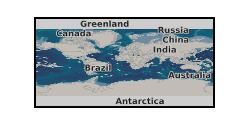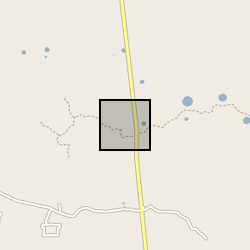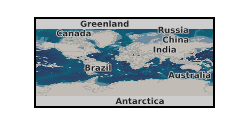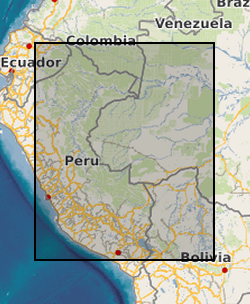Holocene
Type of resources
Available actions
Topics
Keywords
Contact for the resource
Provided by
Years
Formats
Representation types
Update frequencies
-

A new family of spherical harmonic geomagnetic field models spanning the past 9000 yr based on magnetic field directions and intensity stored in archaeological artefacts, igneous rocks and sediment records. The pfm9k geomagnetic field models and datafiles as well as the individual bootstraps of the pfm9k.1b geomagnetic field model presented in A. Nilsson, R. Holme, M. Korte, N. Suttie and M. Hill (2014): Reconstructing Holocene geomagnetic field variation: new methods, models and implications. Geophys. J. Int., doi: 10.1093/gji/ggu120 are included here.
-

Dataset contains an interannual to sub centennial resolution record of carbonate oxygen and carbon isotopes, bulk sediment geochemistry and sedimentology from a 2.95 metre-long core (YC2) from Yaal Chac. The core was dated using a combination of radiocarbon dates and short-lived radio-isotopes. Data are presented in Metcalfe et al (2022) Quaternary Science Reviews https://doi.org/10.1016/j.quascirev.2022.107445
-

Data derived from NERC Grant NE/N001621/1. Geographical Area - DSDP/ODP/IODP Sites 516, 1138, 925, 242, 1338, 871, 872
-
The dataset comprises of analyses of two sediment cores (LC12 and LC7), extracted from Blaso, a large epishelf lake on the margin of 79 degrees N Ice Shelf, NW Greenland in July-August 2017. The data are used to constrain ice shelf dynamics over the last 8500 calibrated years before present (cal. years B.P., where present is A.D. 1950). Data for the LC7 and LC12 sediment records consist of radiocarbon (14C) chronology data. Overlapping 2 m-long sediment cores were recovered with a UWITEC KOL ''Kolbenlot percussion piston corer to a total sediment depth of 3.74 m (LC7) and 5.24 m (LC12). Accelerator mass spectrometry (AMS) was used for radiocarbon (14C) dating. Core LC7: 87 m water depth; 79.589 degrees N, 22.494 degrees E. Core LC12: 90 m water depth; 79.5948 degrees N, 22.44233 degrees E. This project was funded by the Natural Environment Research Council (NERC) through Standard Grant NE/N011228/1. We thank the Alfred Wegner Institute, and particularly Angelika Humbert and Hicham Rafiq, for their significant logistic support through the iGRIFF project. Additional support was provided from Station Nord (Jorgen Skafte), Nordland Air, Air Greenland and the Joint Arctic Command. Naalakkersuisut, Government of Greenland, provided Scientific Survey (VU-00121) and Export (046/2017) licences for this work
-
The dataset comprises multi-proxy analyses sediment core, LC12, extracted from Blaso, a large, epishelf lake on the margin of 79 degrees N Ice Shelf, NW Greenland in July-August 2017. The data are used to constrain ice shelf dynamics over the last ~8500 calibrated years before present (cal. years B.P., where present is A.D. 1950). 2 m-long sediment cores were recovered with a UWITEC KOL ''Kolbenlot'' percussion piston corer to a total sediment depth of 5.24 m. Core LC12 collected from: 90 m water depth; 79.5948 degrees N, 22.44233 degrees E. LC12 sediment records consist of physical properties (magnetic susceptibility, wet bulk density), foraminifera and grain-size data. This project was funded by the Natural Environment Research Council (NERC) through Standard Grant NE/N011228/1. We thank the Alfred Wegner Institute, and particularly Angelika Humbert and Hicham Rafiq, for their significant logistic support through the iGRIFF project. Additional support was provided from Station Nord (Jorgen Skafte), Nordland Air, Air Greenland and the Joint Arctic Command. Naalakkersuisut, Government of Greenland, provided Scientific Survey (VU-00121) and Export (046/2017) licences for this work.
-
The dataset comprises multi-proxy analyses of sediment core, LC7, extracted from Blaso, a large epishelf lake on the margin of 79 degrees N Ice Shelf, NW Greenland in July-August 2017. The data are used to constrain ice shelf dynamics over the last ~8500 calibrated years before present (cal. years B.P., where present is A.D. 1950). A 2 m-long sediment core was recovered with a UWITEC KOL ''Kolbenlot'' percussion piston corer to a total sediment depth of 3.74m. Core LC7: 87 m water depth; 79.589 degrees N, 22.494 degrees E. Geochemical data for the LC7 sediment records consists of XRF-scanner data. This project was funded by the Natural Environment Research Council (NERC) through Standard Grant NE/N011228/1. We thank the Alfred Wegner Institute, and particularly Angelika Humbert and Hicham Rafiq, for their significant logistic support through the iGRIFF project. Additional support was provided from Station Nord (Jorgen Skafte), Nordland Air, Air Greenland and the Joint Arctic Command. Naalakkersuisut, Government of Greenland, provided Scientific Survey (VU-00121) and Export (046/2017) licences for this work.
-
The dataset comprises multi-proxy analyses of sediment core, LC12, extracted from Blaso, a large epishelf lake on the margin of 79 degree N Ice Shelf, NW Greenland in July-August 2017. The data are used to constrain ice shelf dynamics over the last ~8500 calibrated years before present (cal. years B.P., where present is A.D. 1950). A 2 m-long sediment core was recovered with a UWITEC KOL ''Kolbenlot'' percussion piston corer to a total sediment depth of 5.24. Core LC12: 90 m water depth; 79.5948 degrees N, 22.44233 degrees E. Geochemical data for the LC12 sediment records consists of clay mineral, XRF-scanner and biomarker data. This project was funded by the Natural Environment Research Council (NERC) through Standard Grant NE/N011228/1. We thank the Alfred Wegner Institute, and particularly Angelika Humbert and Hicham Rafiq, for their significant logistic support through the iGRIFF project. Additional support was provided from Station Nord (Jorgen Skafte), Nordland Air, Air Greenland and the Joint Arctic Command. Naalakkersuisut, Government of Greenland, provided Scientific Survey (VU-00121) and Export (046/2017) licences for this work.
-

The dataset is the output of a NERC fellowship aimed to understand the long-term dynamics of tropical vegetation through palaeoecological analysis. For doing this, two sedimentary archives (Laguna Pindo and Laguna Baños) from Ecuador were radiocarbon dated and analysed for pollen, non-pollen palynomorphs, charcoal, chironomids, stable isotopes and XRF of tephra deposits. Each proxy was analysed at different resolution. Laguna Pindo is a mid-elevation lake (1250 m asl) that spans the last 50,000 years. Laguna Baños is an Andean lake located at 3800 m asl and contains sediments representative of the last 6500 years. Both water bodies are very shallow. The data is presented mainly in excel spreadsheets as raw data (except for radiocarbon dating data, which are the PDF files provided by NRCF), without any math treatment or conversion. Publication associated with NERC grant, Frazer Matthews-Bird, Stephen J. Brooks, Philip B. Holden, Encarni Montoya, and William D. Gosling (2016), Inferring late-Holocene climate in the Ecuadorian Andes using a chironomid-based temperature inference model. Clim. Past, 12, 1263-1280, 2016. doi:10.5194/cp-12-1263-2016
-

Antarctica and its ice sheets have played, and continue to play, a major role in the global ocean-atmosphere system, hence, it is critical that we have a sound understanding of the past behaviour of Antarctica and it's ice sheets with a view to understanding their potential future variability under a warming climate. The Southern Ocean is a key component of the thermohaline circulation of the world's oceans and the re-distribution of heat and salt around the oceans is integral to processes that regulate rapid climate transitions. Computer modelling results have shown that sufficient melt water input to the Antarctic continental shelf area is capable of shutting down the formation of cold, salty deep water in Antarctica hence upsetting the balance of the thermohaline circulation and the ocean-climate system of the Northern Hemisphere. In order to further investigate these processes that originate in Antarctica, it is necessary to understand the transfer mechanisms of ocean-climate signals from the Antarctic ice sheets, across the continental margin seas, into the Southern Ocean. Exceptionally well-preserved Antarctic margin sediment cores, recovered during the last decade, contain an excellent archive of these ice-ocean-climate interactions, often on seasonal timescales, from the end of the last ice age and throughout the recent warm interglacial (the Holocene). The cores are seasonally layered through the deglaication, intermittently layered through the Holocene, and the layers are dominated by fossil planktonic diatoms (algae); individual species of which are sensitive to sea surface conditions including sea ice concentration, fresh water influx, and open ocean influence upon the margin. Following the last ice age, these Holocene Antarctic sediments record climate fluctuations of tens to thousands of years long and whatever environmental forcing mechanism is responsible for these fluctuations, the changes are likely to be felt in the Antarctic coastal regions first, and the cores proposed for this research are located in prime positions to record these changes. Diatom oxygen isotope measurements represent an under-utilised technique that provides a means of obtaining oxygen isotope records in high latitude environments. The measurement of oxygen isotopes in diatoms is a widely used proxy in the study of the history of lakes, however, to date there have been many fewer attempts to use records of diatom oxygen isotopes in the oceans. Studies that have taken place have demonstrated the sensitivity of diatom oxyegn isotope measurements in polar and sub-polar waters to changes in surface ocean environmental parameters such as salinity, freshwater input and sea surface temperature. The research proposed here will be the first attempt to produce diatom oxygen isotope records from the Antarctic margin, a region sensitive to the waxing and waning of the Antarctic ice sheets in terms of melt water through-put to the Southern Ocean. We propose to investigate the evolution of seasonality along the Antarctic margin since the last ice age, and also the processes involved in producing the sediment record, by relating diatom oxygen isotope measurements on season-specific diatom taxa (i.e. diatom species that thrived particularly in spring or autumn) to relative freshwater influx to the coast, from either melted terrestrial ice or sea ice. We also hope to show that the diatom oxygen isotope measurements will be low at the end of the last ice age, as a large quantity of old ice sheets were melting, and will be higher during warmer time periods of the Holocene when ice sheets were at a minimum.
-
Data for Figure SPM.1 from the Summary for Policymakers (SPM) of the Working Group I (WGI) Contribution to the Intergovernmental Panel on Climate Change (IPCC) Sixth Assessment Report (AR6). Figure SPM.1 shows global temperature history and causes of recent warming. --------------------------------------------------- How to cite this dataset --------------------------------------------------- When citing this dataset, please include both the data citation below (under 'Citable as') and the following citation for the report component from which the figure originates: IPCC, 2021: Summary for Policymakers. In: Climate Change 2021: The Physical Science Basis. Contribution of Working Group I to the Sixth Assessment Report of the Intergovernmental Panel on Climate Change [Masson-Delmotte, V., P. Zhai, A. Pirani, S. L. Connors, C. Péan, S. Berger, N. Caud, Y. Chen, L. Goldfarb, M. I. Gomis, M. Huang, K. Leitzell, E. Lonnoy, J.B.R. Matthews, T. K. Maycock, T. Waterfield, O. Yelekçi, R. Yu and B. Zhou (eds.)]. Cambridge University Press. In Press. --------------------------------------------------- Figure subpanels --------------------------------------------------- The figure has two panels, with data provided for all panels in subdirectories named panel_a and panel_b. --------------------------------------------------- List of data provided --------------------------------------------------- Panel a The dataset contains: - Estimated temperature during the warmest multi-century period in at least the last 100,000 years, which occurred around 6500 years ago (4500 BCE), multi-centennial average, from AR6 WGI Chapter 2 - Global surface temperature change time series relative to 1850-1900 for 1-2020 from: • 1-2000 CE reconstruction from paleoclimate archives, decadal smoothed, from PAGES2k Consortium (2019, DOI: 10.1038/s41561-019-0400-0) • 1850-2020 CE, observations, decadal smoothed, from AR6 WGI Chapter 2 assessed mean Panel b: The dataset contains global surface temperature change time series relative to 1850-1900 for 1850-2020 from simulations from the sixth phase of the Coupled Model Intercomparison Project (CMIP6) and observations: - CMIP6 historical+ssp245 simulations (simulations with human and natural forcing, 1850-2019) - CMIP6 hist-nat simulations (simulations with natural forcing, 1850-2019) - Global Surface Temperature Anomalies (GSTA) relative to 1850-1900 from observations assessed in IPCC AR6 WG1 Chapter 2 (1850-2020) --------------------------------------------------- Data provided in relation to figure --------------------------------------------------- Panel a: - panel_a/SPM1_1-2000_recon.txt, 1-2000 time series, decadal smoothed, for years centered on 5-1996 CE [column 1 grey line, columns 2 and 3 grey shading] - panel_a/SPM1_1850-2020_obs.txt, 1850-2020 time series, decadal smoothed, for years centered on 1855-2016 CE [black line] - panel_a/SPM1_6500_recon.txt, bar for the warmest multi-century period in more than 100,000 years (around 6500 years ago: 4500 BCE) [grey bar] Panel b: - panel_b/gmst_changes_model_and_obs.csv. Global surface temperature change time series relative to 1850-1900 for 1850-2020 from: • CMIP6 historical+ssp245 simulations (1850-2019) [mean, brown line] • CMIP6 historical+ssp245 simulations (1850-2019) [5% range, brown shading, bottom] • CMIP6 historical+ssp245 simulations (1850-2019) [95% range, brown shading, top] • CMIP6 hist-nat simulations (1850-2019) [mean, green line] • CMIP6 hist-nat simulations (1850-2019) [5% range, green shading, bottom] • CMIP6 hist-nat simulations (1850-2019) [95% range, green shading, top] • Global Surface Temperature Anomalies (GSTA) relative to 1850-1900 from observations assessed in IPCC AR6 WG1 Chapter 2 (1850-2020) [black line] --------------------------------------------------- Sources of additional information --------------------------------------------------- The following weblinks are provided in the Related Documents section of this catalogue record: - Link to the report webpage, which includes the report component containing the figure (Summary for Policymakers), the Technical Summary (Cross-Section Box TS.1, Figure 1a) and the Supplementary Material for Chapters 2 and 3, which contains details on the input data used in Tables 2.SM.1 (Figure 2.11a) and 3.SM.1 (Figure 3.2c; FAQ 3.1, Figure 1). - Link to related publication for input data
 NERC Data Catalogue Service
NERC Data Catalogue Service